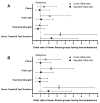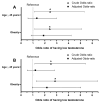Association of Endogenous Testosterone with Physical Fitness Measures during Firefighter Occupational Health Evaluations
- PMID: 38541275
- PMCID: PMC10969807
- DOI: 10.3390/ijerph21030274
Association of Endogenous Testosterone with Physical Fitness Measures during Firefighter Occupational Health Evaluations
Abstract
Firefighting is a physically demanding profession associated with unacceptably high on-duty cardiovascular mortality. Low endogenous total testosterone (TT) is an emerging cardiometabolic (CM) risk factor in men, but limited data exists on its interactions with physical fitness (PF). Data from occupational health and fitness assessments of 301 male career firefighters (FFs) were analyzed. TT was categorized as low (<264 ng/dL), borderline (264-399 ng/dL), and reference (400-916 ng/dL). PF tests included cardiorespiratory fitness (submaximal treadmill), body fat percentage (BF%), push-ups, plank, and handgrip strength assessments. In the crude analyses, FFs in the low TT group had worse muscular and cardiorespiratory fitness measures compared to the referent group. However, after adjusting for age and BF%, none of the PF differences remained statistically significant. Similarly, the odds of less-fit FFs (PF performance below median values) having low TT were higher compared to the fitter ones only before adjusting for age and BF%. Therefore, in the final adjusted model, there was no significant association between TT and PF. Our data suggest that age and body fat confound the association between PF and TT. Low TT and poor PF are important components of FFs' CM risk profile, and there is potential benefit to considering TT screening as part of a comprehensive occupational health program that manages performing medical evaluations and provides education and preventative programming.
Keywords: cardiometabolic; cardiovascular; public safety; risk; workforce.
Conflict of interest statement
DLS served as a consultant in cases involving firefighters’ cardiac health. The remaining authors have no disclosures to report.
Figures


Similar articles
-
Physical fitness profile of a large urban fire department: Exploring age and rank dynamics.Work. 2024;79(4):2059-2073. doi: 10.3233/WOR-240150. Work. 2024. PMID: 38968036
-
Borderline-low testosterone levels are associated with lower left ventricular wall thickness in firefighters: An exploratory analysis.Andrology. 2020 Nov;8(6):1753-1761. doi: 10.1111/andr.12860. Epub 2020 Sep 3. Andrology. 2020. PMID: 32633472 Free PMC article.
-
Longitudinal changes in cardiorespiratory fitness among firefighters based on a fixed 12.0 MET standard and an age-adjusted fitness standard.Work. 2023;76(2):821-829. doi: 10.3233/WOR-220608. Work. 2023. PMID: 36938771
-
What do Firefighting Ability Tests Tell Us About Firefighter Physical Fitness? A Systematic Review of the Current Evidence.J Strength Cond Res. 2020 Jul;34(7):2093-2103. doi: 10.1519/JSC.0000000000003577. J Strength Cond Res. 2020. PMID: 32287090
-
Cardiovascular Disease Risk Factors, Musculoskeletal Health, Physical Fitness, and Occupational Performance in Firefighters: A Narrative Review.J Environ Public Health. 2022 Sep 19;2022:7346408. doi: 10.1155/2022/7346408. eCollection 2022. J Environ Public Health. 2022. PMID: 36193397 Free PMC article. Review.
Cited by
-
Comparison Between Disability, Physical Performance, and Other Biopsychosocial Factors in Full-Duty Career Firefighters Working With and Without Current Low Back Pain.Cureus. 2024 Jun 11;16(6):e62189. doi: 10.7759/cureus.62189. eCollection 2024 Jun. Cureus. 2024. PMID: 39006584 Free PMC article.
References
-
- Standard on Comprehensive Occupational Medical Program for Fire Departments. NFPA; Quincy, MA, USA: 2022. [(accessed on 27 September 2023)]. Available online: https://www.nfpa.org/codes-and-standards/all-codes-and-standards/list-of....
MeSH terms
Substances
Grants and funding
LinkOut - more resources
Full Text Sources
Miscellaneous

